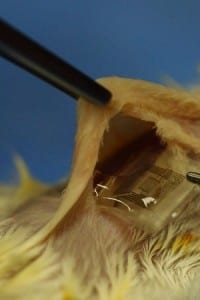
The boundary that divides man from machine continues to dissolve — and in more literal ways than you might imagine.
Scientists today announced a new class of electronics that can disappear completely, resorbing into its environment after carrying out a designated task.
The potential applications of this technology — dubbed “Transient Electronics” by its creators — are many, and they run the gamut from vanishing biological implants to environmentally friendly cell phones. To learn more, we spoke with lead researcher John Rogers and bioengineer Todd Coleman about evanescent electronics, and how they stand to revolutionize humanity’s relationship with technology.
Traditional electronics are hard and unyielding. This is often perceived as a good thing. The stiffness of a computer chip bespeaks strength, its physical invariance reliability.
And yet, the physical rigidity of most modern technology is analogous to its practical limitations, in that it is not easily adaptable. Some applications call for a softer, or less permanent solution that the vast majority electronics just can’t provide. That’s where John Rogers comes in.
Rogers is an engineer at The University of Illinois at Urbana–Champaign, where he studies and applies the characteristics of “soft” materials in ways that are transforming how we think about electronics. Last year, Rogers’ group unveiled an “epidermal electronic system” — an electronic circuit, applied to the skin like a temporary tattoo, that can stretch, flex and twist as a person moves. The announcement marked an impressive leap forward in the field of biocompatible electronics.
And now, with the introduction of transient electronics, Rogers and his colleagues have taken the concept of dynamic, unobtrusive, and biocompatible technology to an entirely separate plane.
“The history of development in electronics has, up to now, focused on the development of devices that last forever, with stable performance,” Rogers tells io9. “We are postulating that devices with the opposite behavior — that is, physical transience in a manner with engineering control — could open up different, complementary kinds of applications.”
In today’s issue of Science, Rogers and his team have demonstrated the use of their system in a biomedical setting by embedding transient circuits in the surgical wounds of mice. These devices were programmed to not only fight infection (heat generated by the circuit acts as a bacteriocide, curbing the proliferation of potentially harmful microorganisms), but to resorb through the tissue, after exposure to a certain amount of the mouse’s own biological fluids.
In many cases, explains Rogers, “interventional function is needed only during a healing period,” after which the device is no longer needed. “Instead of leaving them in the body, as an unnecessary device load, or instead of performing a surgical removal process, the best thing is for the device to resorb and disappear in the body.”
Three weeks after implantation, the researchers found reduced infection at the wound site, trace residues of the transient circuit, and evidence of slow reintegration into the the layers of tissue beneath the skin. Signs of revascularization (the restoration of circulation at the point of injury — an important part of the healing process) were observed, as well.
The secret to transient electronics’ disappearing act are the materials used to create them. The circuits implanted in the mice were crafted from sheets of porous silicon and magnesium electrodes, then packaged in silk collected from silkworm cocoons. By tweaking the crystalline structure of the silk, the researchers can control how quickly it dissolves, be it over a matter of seconds or several years.
All of these materials are capable of being broken down and reassimilated into their environment. The amount of silicon in a transient circuit comes in at well below your daily recommended allowance, and the magnesium content is less than what you find in a multivitamin.
via IO9 – Robert T. Gonzalez
The Latest Streaming News: Electronic implant updated minute-by-minute
Bookmark this page and come back often
Latest NEWS
Latest VIDEO







